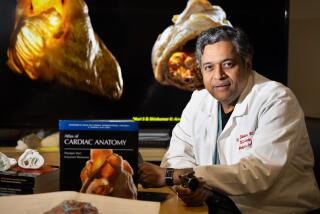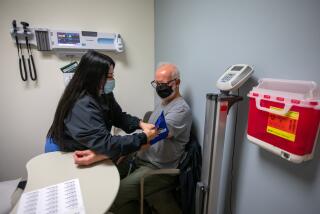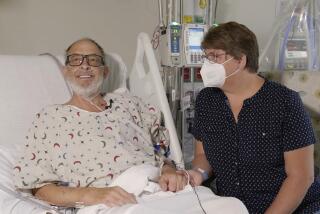Medical Guinea Pigs: Where Thereâs Life . . .
He knew his death was imminent and had little hope the new machine that would replace his heart would keep his failing body alive. But he was ready to claim his place as a pioneer in medical history.
âIt would really give purpose to my life, and purpose to my death,â the 61-year-old patient said, according to his widow.
A generation ago, America watched awe-struck as Barney Clark blazed a medical trail, receiving the first permanent artificial heart in a dramatic operation that seemed to revolutionize medicine.
Now, a new drama is being played out at a Kentucky hospital where a critically ill man has become the first recipient of a self-contained artificial heart. His surgery will someday be documented in medical journals, but his bold decision already has raised the question: What motivates a dying person to volunteer for risky, experimental heart surgery knowing the final days or months of life could be marred by medical complications and more pain?
Little is known about the man who received the heart on July 2 at Jewish Hospital in Louisville. He is a diabetic in his 50s, had multiple heart attacks and was expected to die within 30 days. But others who have participated in history-making research offer some clues to why people become human guinea pigs.
Family members and doctors of these patients, along with ethicists, say the reasons are fairly basic: a strong desire to live, altruism and, perhaps, a deep-seated belief by some that they will defy the long odds.
âWe as human beings tend to look for hope,â says Jonathan Moreno, director of the Center for Biomedical Ethics at the University of Virginia. âWeâre accustomed to remarkable technological breakthroughs, so itâs not a leap of the imagination to believe you could survive.â
Moreno says studies conducted since the mid-1980s have shown the vast majority of volunteers for cancer or HIV research who are sick are looking for personal benefit âeven when it has been made clear to them the study is not intended to benefit them or itâs unlikely to benefit them.â
Yet doctors refer patients to research more than they did three or four decades ago, says Paul Root Wolpe, a faculty associate at the Center for Bioethics at the University of Pennsylvania. âIt has,â he says, âbecome your last great hope to be saved.â
âPeople underestimate the risks of what theyâre doing,â he adds. âThey end up not really recognizing that research is chancy.â
But some patients-turned-pioneers also are inspired to help others, according to Wolpe.
âMaybe itâs cancer, maybe itâs heart disease,â he says, âbut [they believe] âI can strike my blow against this scourge thatâs taking my life by contributing to its defeat.â â
Thatâs what motivated Clark, who survived 112 days with the Jarvik-7 heart after his landmark 1982 surgery, says his widow, UnaLoy Clark-Farrer.
âHe had faced his mortality,â she says. âHe knew he was going to die. He knew he had to be in that position [for doctors] to consider him. He saw it as a real opportunity for him to contribute something to medical science.â
Dr. William DeVries, who achieved his own measure of fame as Clarkâs surgeon, says the retired Seattle dentist believed the odds were stacked against him but was determined to proceed.
âHe said, âIâve been kept alive by drugs that others have been giving their lives for, and now itâs my turn to pay them back,â â the doctor recalls.
Clark suffered from bouts of depression and his mobility was severely restricted on the Jarvik-7, with its protruding wires, tubes and washing machine-sized generator--all of which raised ethical questions about his quality of life.
In contrast, the patient at the Kentucky hospital has a grapefruit-sized titanium-and-plastic pump known as the AbioCor. The device, produced by Abiomed Inc., is self-contained and operates with batteries so no wires come through the skin.
Abiomed also has created an eight-member council of independent patient advocates to help guide potential patients and their families.
DeVries, now an academic coordinator at Walter Reed Army Medical Center in Washington, says that when he implanted artificial hearts in the early to mid-1980s, potential candidates had to have strong family support to be eligible. That was especially important if the patient became unconscious and critical decisions had to be made.
Although there is no singular profile of patients who volunteer for experimental research, DeVries says there are common traits.
âTheyâre independent people who want to leave a mark,â he says. âTheyâre tough.â
He points to another of his patients, William Schroeder, who lived 620 days with the Jarvik 7--the longest survivor of any of those with the device--before dying in 1986.
âHe looked at it almost as a personal challenge,â DeVries says. âHe wanted to help others, but he also wanted his life to be saved.â
DeVries says Schroeder wanted to see his sonâs wedding and the birth of his grandchild--and he did.
Margaret Schroeder, his widow, remembers many poignant moments: the day her husband donned a tuxedo for their sonâs mock wedding in the hospital; their 34th anniversary celebration at a Red Lobster restaurant; the baptism of their grandson; the parade in their hometown of Jasper, Ind., where he was grand marshal.
But Schroeder, who was able to live in a special apartment outside the hospital, suffered a series of debilitating strokes, and his ordeal was regarded by some as helping sway public opinion against the procedure.
âToward the end, then, it wasnât so nice,â his widow recalls. âBut Iâm not sorry we did it. Bill wanted to do it and we wanted to help him make it through as long as he could.â
Doctors say that human guinea pigs are invaluable in helping further science and in drawing attention to a particular health problem--such as the need for organ donors.
Thatâs seen as the legacy of one of the most controversial firsts--the 1994 surgery at Loma Linda University Medical Center in California to save a newborn named Baby Fae with a walnut-size baboon heart.
That case, which sparked protests by animal rights activists, stirred debate about the ethics of using an organ from another species as well as subjecting a newborn to an experimental operation.
When Baby Fae died 20 1/2 days after the transplant, âthe mother came to me and said, âI hope you wonât give up. What you have done is very, very important,â â says Dr. Leonard Bailey, professor and chairman of the department of surgery at Loma Linda, who performed the operation.
Bailey says Loma Linda has performed scores of heart transplants of infants who have survived 10 years or more. âAll this in my view is because of the public awareness brought about by Baby Fae,â he says.
As for Barney Clarkâs widow, she supports the continuing work on artificial hearts--and has no regrets.
âI had never been more proud of him and never loved him more than the night he died,â she says. âWhen they talked about whether it was a success or not, it was a success. He gave it everything he had.â






